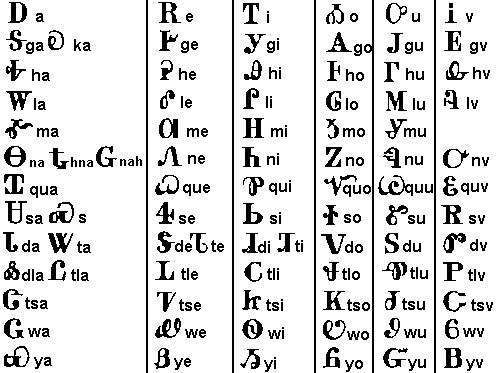


a, as a in father, or short as a in rival
e, as a in hate, or short as e in met
i, as i in pique, or short as i in pit
o, as o in note, approaching aw as in law
u, as oo in fool, or short as u in pull
v, as u in but, nasalized
g, nearly as in English, approaching k
d, nearly as in English, approaching t
h, k, l, m, n, q, s, t, w, and y, as in English.
Note that do, du and dv are sounded as to, tu
and tv in some words. In fact to, tu and tv
could have had their own symbols according to some.
Since they don't, the symbols used are still do, du and dv.
Sometimes vowels are unvoiced. When this is the case,
I have used parenthesis around the approprate syllable
(a common transcriotion).
Note that the consonant of that syllable is still pronounced,
with the preceeding syllable. EXAMPLE:
mock is: a-ye-(li)-di and
pronounced: a-yel-di
However, if I put two vowels in parenthesis, it represents
alternate forms. EXAMPLE:
crow is: ko-g(i)(a) whitch means that ko-gi or ko-ga are both correct.
Also
A ? represents a glottal stop, like the sound
between the syllables of Uh-Oh.
A : after a vowel means that this vowel is
doubled, taking twice as long to say.
An ' after a syllable shows an accent on that syllable.
An ' after the consonant of a syllable shows
that a vowel has been left out.
The syllables with "ts" can be pronounced with
a "j" sound.
| History of the Cherokee Language | Syllabray Table | Syllabray Table to Print |
| Language History | Language Lessons | Download Audio Syllabary |
| Miscellaneous Words | nouns § verbs § names |
| Back | Home |
 Visitors
Visitors